TOPIC 2: Definition & Dimension
1/112
Earn XP
Description and Tags
Flashcards based on those created by @maledine
Name | Mastery | Learn | Test | Matching | Spaced |
|---|
No study sessions yet.
113 Terms
Microbiology
Branch of biology that deals with the study of microorganisms
Bacteriology
Virology
Mycology
Parasitology
Immunology
Branches of microbiology
Bacteriology
Study of bacteria (bacterium)
Bacteria
Minute, unicellular organisms that have all the necessary protoplasmic equipment for growth and self-multiplication at the expense of available foodstuffs
Widely distributed
Normal Flora
Microorganisms that live on another living organism without causing a disease;
However sometimes, they are opportunistic and adapt by undergoing mutation as they adjust to the environment, which becomes a pathogen
Pathogen
Bacteria/viruses/microorganisms that cause a disease
Virology
Study of viruses
Obligate Intracellular Parasites
Viruses are these, which are parasites that can reproduce only within a living cell (may survive for a short while outside cell, nonliving outside cells)
DNA or RNA, but NOT both
Viruses can either have _________
Capsid (protein shell)
floating shell of the virus
Protects nucleic acid from digestion by enzymes.
Contains special sites on surface allowing viruses to attach to host cell.
Provides proteins enabling viruses to penetrate the host’s cell membrane and eject infectious nucleic acid into the cell cytoplasm
3 Functions of the Capsid of a Virus
Bacteriophage
Virus may become this which is a virus that parasitizes a bacterium by infecting it and reproducing inside it.
Naked virus
Identify the type of virus shown.
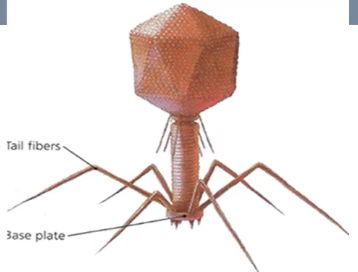
Virus with capsid inside
Identify the type of virus shown.

Mycology
Study of fungi
Yeast (Monomorphic)
Yeast & mold/filamentous (dimorphic)
Fungi can either exist as either…
Monomorphic
Fungi that exists as yeast
Dimorphic
Fungi that exists as yeast and mold
Mold
What type of fungi is shown?
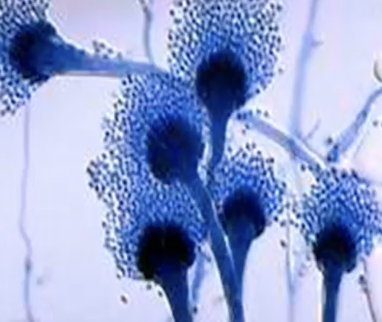
Malassezia furfur
What species of a fungus is naturally found on the skin surfaces of humans but may overgrows and interferes with the normal pigmentation of the skin which results to small discolored patches?

Tinea versicolor
Discolored patches on the skin caused by Malassezia furfur

Parasitology
Study of parasites
Flagellates
Amoebae
Sporozoans
Nematodes
Trematodes
Cestodes
Types of Parasites
Trichomonas vaginalis
Identify the parasite (specifically a flagellate) shown in the picture, which is causative agent of the STD trichomoniasis.
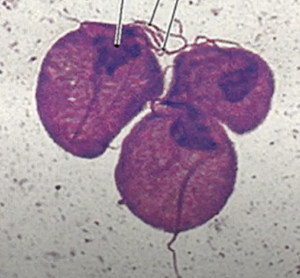
Amoeba
Identify the parasite.
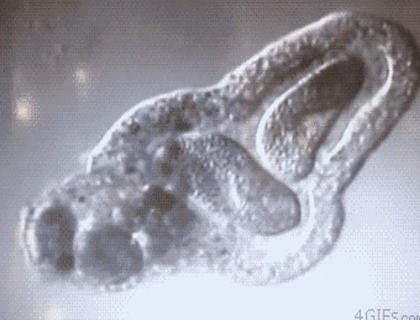
Plasmodium
Identify the parasite.

Flagellates
(parasitology)
Cells/organisms with one or more whiplike appendages (flagella)
Amoebae
(parasitology)
Single-cell eukaryotic organism with no definite shape and move by means of pseudopodia
Nematodes
(parasitology)
Round worms
Trematodes
(parasitology)
Flat worms
Cestodes
(parasitology)
Tape worms
Has hooks that allow it to attach to the host
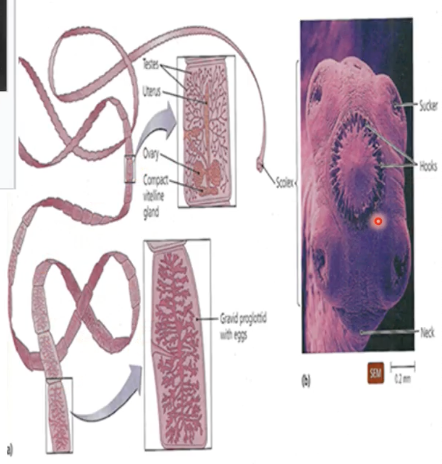
Ascaris Egg
Identify the type of parasite.
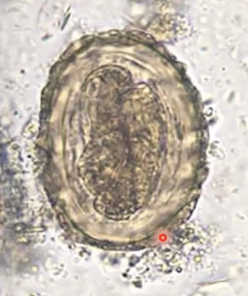
Schistosomes
(parasitology)
“Loving” flatworms
Gonochoristic = have distinct sexes (male or female)
Male surrounds female and encloses with gynecoforic canal and brings female along with him
Male feeds on host’s blood and passes to the female, as well as chemicals which help females develop
Sometimes “divorce” when female jump to another male
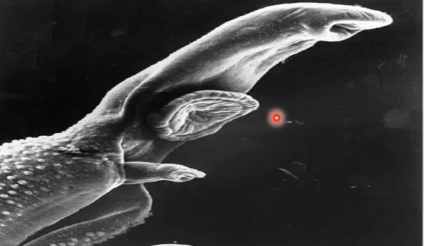
Elephantiasis
(parasitology)
caused by parasitic roundworms: wuchereria bancrofti and brugia malayi

Wuchereria bancrofti and brugia malayi
(parasitology)
parasitic roundworms that cause Elephantiasis
Immunology
Study of the immune system
Cells, molecules and mechanisms, immunity
Phagocytosis
First line of defense in immune system
Prokaryotes
Eukaryotes
2 classification of organisms based on type of cell organization and function
Bacteria
Archaea
Eukarya
Taxonomists have placed all microorganisms into 3 domains which are:
Prokaryotes
Unicellular organisms that lack a membrane bound nucleus, a mitochondria and other membrane bound organelles
Distinctive structural feature is not what they have but what they lack
Lack membrane surrounding their DNA and nucleus, rather have a nucleoid
What do prokaryotes lack based on light microscopy (LM)?
Nucleoid
In prokaryotes, where the single chromosomal circular double-stranded DNA molecule is located
Lack the membrane-bound organelles
What do prokaryotes lack based on electron microscopy (EM)?
Bacteria
Archaea
2 domains included in prokaryotes
Archaea (Archaeobacteria)
Domain of bacteria that appears more closely to eukaryotic cells, found in microorganisms that grow in extreme environmental conditions.
Nucleotide sequence of their ribosomal RNA
Type of lipids in cytoplasmic membranes
Chemistry of cell walls
What do Bacteria and Archaea differ in?
Peptidoglycan
What does the archaea cell wall lack which is a major reason why they are placed in a separated domain from bacteria?
Gram (+) Archaea
Archaea that have thick walls and stain purple
Gram (-) Archaea
Archaea that have layer of protein covering cell wall and stain pink
Eukaryotes
Organisms whose cells have a membrane surrounding their DNA forming a nucleus.
Have internal membrane-bound compartments (organelles)
Cells of algae, protozoa, fungi, animals and plants are eukaryotic
Larger in size and more complex than prokaryotes
Endoplasmic Reticulum
(Eukaryote Organelle)
Process and transport proteins
Golgi Body
(Eukaryote Organelle)
Modification of substances and transport throughout the cell, including internal delivery of molecules, and exocytosis or secretion of other molecules
Mitochondria
(Eukaryote Organelle)
Generate energy (ATP)
Lysosomes
(Eukaryote Organelle)
Provide an environment for controlled enzymatic degradation of intracellular substances
Nucleus
(Eukaryote Organelle)
Provide a membrane enclosure for chromosomes
Taxonomy
Orderly classification of organisms into categories
Taxa
Organization of microorganisms that share similar morphologic, physiologic, and genetic traits into specific groups
Based on similarities and differences of genotype and phenotype
Genotype
Genetic makeup of an organism or combination of forms of one or more organisms genome
Phenotype
Observable physical and functional features of an organism expressed (i.e., Microscopy of cells)
Domain
Kingdom
Phylum
Class
Order
Family
Genus
Species
8 Taxa in order
Domain
(Taxa)
bacteria, archaea, eukarya
Eukarya
Bacteria
Archaea
According to Carl Woese’s discovery, what are the three domains based on the nucleotide sequence of rRNA?
Kingdom
(Taxa)
phyla, most inclusive taxa
Phylum
(Taxa)
have similar classes
Class
(Taxa)
similar orders
Order
(Taxa)
similar families
Family
(Taxa)
similar genera
Genus
(Taxa)
similar species
Species
(Taxa)
specific epithet, most exclusive taxa
ex: areus in Staphylococcus areus
Carl Woese
Who used rRNA sequences to propose a new classification system?
rRNA (ribosomal RNA)
What molecule did Carl Woese study to classify organisms?
Domain
What new taxonomic rank did Carl Woese propose?
One or more kingdoms from the Linnaean system.
In Woese’s system, what does each domain include?
16S ribosomal RNA (rRNA)
What molecule is the 3-domain classification system based on?
Svedberg unit – a measure of sedimentation rate
What does the “S” in 16S rRNA stand for?
Prokaryotic ribosomes, mitochondria, and chloroplasts.
Which cellular structures contain 16S rRNA?
Bacteria
environmental prokaryote
cyanobacteria
heterotropic medically relevant bacteria
Archaea
environmental isolates that live in extreme environments
high Na conc, jet fuel or extreme temp
Eukarya
true nucleus
contain medically relevant orgs including fungi and parasites
Nomenclature
Term for accepted labels by which organisms are universally recognized
Binomial System
scientific naming system of organisms
Carolus Linnaeus
Developed this system where each organism is given 2 names, the Genus name and the specific epithet. 2 names refer to the species
Family name should be capitalized and has an aceae ending
The genus name is capitalized and followed by the species epithet
Both genus and species should be italicized in print - Staphylococcus aureus but underlined when written in script - Staphylococcus aureus
Often the genus name is abbreviated by the use of the first letter of the genus followed by a period and the species epithet -S. aureus
Species are abbreviated sp (singular) and spp (plural) if species not specified
Rules for nomenclature
Genus
Comprised of different species that have several important features in common but differs sufficiently to still maintain their status as individual species
First word, example Staphylococcus is this in Staphyloccocus Aureus
Species
Collection of bacterial strains that share many common physiologic and genetic features and as a group differ notably from other bacterial species
most basic of the taxonomy groups
subspecies
Occassionally, taxonomic groups as ___ are recognized within a species
Biotype
Serotype
Phagotype
What terms are used for a group within a species that has specific, minor differences?
subspecies
What is a subgroup within a species called when officially recognized in taxonomy?
Biotype
Same species with the same genetic makeup but displays differential physiological characteristics
According to biochemical test results
Klebsiella pneumoniae
Klebsiella oxytoca
2 distinct species within the genus, Klebsiella
Serotype
Differentiation is the distinct variation within species of bacteria, virus or among immune cells of different individuals classified together based on their surface antigen
Phagotype
Strain of bacterium that is sensitive to a certain bacterialphage or set of bacteriophages
Based on the susceptibility of to a certain bacteria
Genotypic Characteristics
Phenotypic Characteristics
How to identify bacteria?
DNA base composition ratio
Nucleic acid base sequence analysis or homology
Criteria for genotypic characteristics
Genotypic characteristics
(categories for identification)
because of the age of genomics, organisms can now be identified by their molecular structures
by the DNA or RNA components
DNA Base Composition Ratio
(Genotypic characteristics)
indicates the relatedness of the organisms
when guanine and cytosine differs by a small percentage, the organisms are not closely related
relatedness of bacteria is reflected in the chemical makeup of their DNA molecules and they can be quantitatively measured as the mean molar percentage of G + C
Nucleic Acid Base Sequence Analysis or Homology
(Genotypic characteristics)
Assessed by using Nucleic Acid Hybridization
Nucleic Acid Hybridization
Refers to a molecular biology technique that measures degree of genetic similarity between pools of DNA sequences
used to determine the genetic distance between 2 organisms
Helps assess nucleic acid base sequence analysis or homology
Phenotypic characteristics
(categories for identification)
expression of the genotype
Microscopic morphology
Staining characteristics
Environmental requirements
Nutritional requirements
Macroscopic morphology
Subcellular properties
Resistance profiles
Antigenic properties
Criteria for phenotypic characteristics